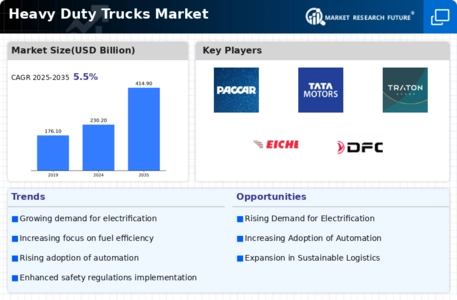Market Share
Heavy Duty Trucks Market Share Analysis
Logistics companies find themselves amidst an era of unprecedented transformation, driven by the widespread adoption of digitization and evolving customer expectations. New technological advancements are ushering in greater operational efficiency and fostering more collaborative operating models. As a result, these advancements are poised to play a significant role in propelling the electric truck market forward.
In the United States, the logistics and transportation industry operates within a highly competitive landscape. The rapid surge in e-commerce sales has been a pivotal force driving changes within the logistics sector. According to the International Trade Administration (ITA), e-commerce logistics spending in the US reached USD 119 billion in 2019, representing 7.0% of the nation's total logistics costs—an increase from 4.8% in 2018. This substantial growth in e-commerce has led to a surge in low-value shipments. Consequently, retailers are increasingly decentralizing their distribution centers and establishing "last-mile" fulfillment centers, strategically placing inventory closer to consumers. This surge in demand for electric trucks stems from the need to transport inventory to these nearby distribution centers, promoting zero-emission transportation practices.
America's intricate supply chain network links producers and consumers through a myriad of transportation modes, encompassing air and express delivery services, freight rail, maritime transport, and truck transport. To efficiently serve customers, both multinational and domestic firms provide tailored logistics and transportation solutions, ensuring seamless movement of goods from origin to end-user across diverse supply chain networks, including truck transport. Moreover, trucking accounts for the majority of overland logistics activities in the US, with the market valued at USD 796.7 billion in 2018. At that time, the industry faced a shortage of truck drivers, despite employing over 928,000 individuals—a shortfall compared to the logistics industry's needs.
Medium-duty trucks cater to over-the-road transportation of cargo across short and medium distances. According to the American Trucking Associations, trucking revenues reached USD 700 billion in 2017, with trucks moving nearly 11 billion tons of freight that year. However, in 2018, trucking emerged as the dominant mode of transportation spend in the US. Inclusive of private fleets and less-than-truckload (LTL) services, trucking revenues nearly touched USD 800 billion. With the rise of e-commerce, parcel transportation emerged as the second-largest mode after trucking. Rail, encompassing intermodal rail, held the third position, accounting for 8% of the nation's freight transportation revenue in 2018.
This surge in logistical activities underscores the growing demand for electric trucks to cater to these expanding operations. Consequently, the burgeoning logistical landscape is anticipated to create ample opportunities for the global electric truck market during the forecast period.

















Leave a Comment